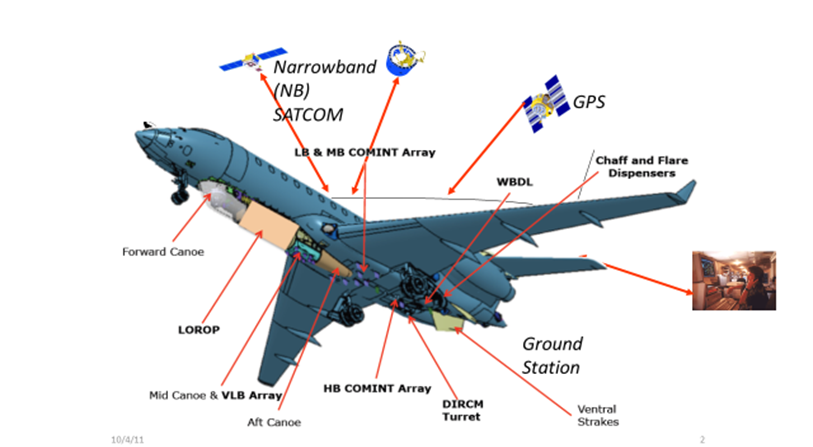Tactical Surveillance
As a first example a typical legacy Tactical Surveillance Task is performed by Mission Aircraft dedicated to Maritime Patrol missions (P3C, NIMROD, ATLANTIC 2…), AEW (AWACS, EMB145 AEW), AGS (JSTARS, ASTOR…), or homeland security missions, such as maritime surveillance, border and assets surveillance performed by a number of drones (this last application is recently a much growing one).
Mission Aircraft are equipped with high technology Sensor systems, such as:
- SAR MTI, and even GMTI
- Maritime surveillance radars with ISAR or HSS modes
- FLIR
- SATCOM
- AIS
- High speed data links
The system also includes tactical consoles presenting to the observer the situational awareness, and the identification images of the suspect target (at sea or on the ground).
Mission Airborne Solutions are now evolving with the Networking of manned and unmanned platforms allowing building a system of systems “force multiplier” for the Military Forces, making those systems interoperable.
A Signals Intelligence (SIGINT) aircraft gives a second example; it collects adversary intelligence from:
- its communications (comms, COMINT),
- Radio Frequency electronic signals not related to comms (ELINT)
- and information systems.
One of the most important SIGINT tasks is the determination of the Electronic Order of Battle (EOB), which encompasses the localization, the identification of the Radars and Comms Nodes associated to the Weapon Systems, and the Networks displaced in the adversary territory.
The SIGINT task is usually accomplished by powerful Signal Receivers and Data Processors that feed Monitors supervised by a number of skilled Signal Corps operators.
The equipment is provided also with large capacity Data Recorders for the subsequent delivery of the mission-recorded data to the further SIGINT Ground Base analyses.

Figure 1: Configuration of a SIGINT Airborne Platform
Modern (and even more in the next future) Comms and Electronic Signals equipment are adopting a number of Electronic Protection Measures (EPM) to their Signal Generation Techniques (such as Spread Spectrum, SDR, LPI, Cognitive Waveforms etc.) in order to prevent (or at least strongly reduce) their detection and classification from the SIGINT Aircraft.
This new situation is tackled by adding to the mission a number of specialized (either ELINT or COMINT) drones which are addressed by the SIGINT A/C towards the presumed zones provided with the above equipment in order to provide better detection, recording and Change Detection information of their signal transmissions.
A further example of Tactical Surveillance System operating on the ground and coastal areas is the Multi-dimensional Networked System (MNS) that consists of a number of multiple monostatic and bi-static channels of observation ( radar and ESM systems), which allow for the recognition, classification and geolocation of threat emitters.
The main operational benefit of this kind of system is that the different elements of the network can jointly exploit in real-time both the detection and recognition of targets as well as the identification of the threat emitter signals.
The geometry dependent data fusion algorithms built on these systems can strongly improve their recognition capability, by using artificial intelligence techniques, which aggregate and distribute in the network the information provided by the system components.







